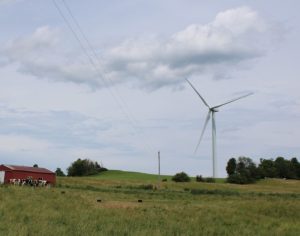BINGHAMTON — Through 2011, New York state residents and companies installed solar systems that generated 83 megawatts of solar power. By the end of 2016, that number had jumped to about 744 megawatts, an increase of just under 800 percent. The growth of solar installations is part of Gov. Andrew Cuomo’s Reforming the Energy Vision […]
Get Instant Access to This Article
Become a Central New York Business Journal subscriber and get immediate access to all of our subscriber-only content and much more.
- Critical Central New York business news and analysis updated daily.
- Immediate access to all subscriber-only content on our website.
- Get a year's worth of the Print Edition of The Central New York Business Journal.
- Special Feature Publications such as the Book of Lists and Revitalize Greater Binghamton, Mohawk Valley, and Syracuse Magazines
Click here to purchase a paywall bypass link for this article.
BINGHAMTON — Through 2011, New York state residents and companies installed solar systems that generated 83 megawatts of solar power. By the end of 2016, that number had jumped to about 744 megawatts, an increase of just under 800 percent. The growth of solar installations is part of Gov. Andrew Cuomo’s Reforming the Energy Vision (REV) plan to generate 50 percent of the state’s energy consumption from renewable resources by 2030.
CPACE
A key element of the governor’s plan is Property Assessed Clean Energy (PACE). In November of last year, the state legislature created Commercial PACE (CPACE), designed to help commercial properties make energy-efficiency and renewable-energy upgrades to buildings. CPACE, which is formally known as Energize NY Commercial Financing, helps property owners find incentive programs; identify reliable and certified contractors and engineering firms; access low-cost, long-term financing; and create a post-upgrade plan to verify and measure the energy savings. The end result is that building owners enjoy an increase to the property’s value, all while generating positive cash flow from reduced energy costs.
 Enter Southern Tier Solar Works (STSW). “We’re the clean-energy, outreach-and-marketing program of the Binghamton Regional Sustainability Coalition,” says Michael Treiman, STSW solutions manager.
Enter Southern Tier Solar Works (STSW). “We’re the clean-energy, outreach-and-marketing program of the Binghamton Regional Sustainability Coalition,” says Michael Treiman, STSW solutions manager.
The coalition was formed in 2008 as a 501(c)(3) nonprofit corporation to improve the quality of life in the Binghamton region, which includes shifting to more sustainable energy sources. “STSW focuses on developing the solar industry in our region through education and outreach. While our primary regional focus is on five counties — Broome, Chenango, Delaware, Otsego, and Tioga — we respond to inquiries from across the Southern Tier. Most of our efforts have been directed to the residential sector educating homeowners to the benefits of clean energy, vetting local solar installers, providing free assessments, and helping with applications. With the passage last year of Energize NY Commercial (CPACE) financing, however, we have expanded our efforts to the commercial sector. Research shows that the Southern Tier has a tremendous potential estimated at 100,000 square-kilometers of solar space on rooftops and ground level. To date, Broome is one of only 13 municipalities to adopt the local law required to enable CPACE financing, which makes solar and other clean-energy measures more affordable to business and nonprofit building owners.”
Municipal projects
STSW has not limited itself to just residential and commercial solar projects. “On May 6, we launched a solar-art workshop at the University Downtown Center as part of our ‘solarize’ campaign. We want to develop public green spaces that integrate solar power with sculpture and design. The workshop is a technical and artistic collaboration that brings community members, artists, engineers, and architects together. We invited the Land Art Generator Initiative (LAGI) from Pittsburgh to help us with the launch to generate ideas for sustainable-energy infrastructures that enhance our cities by providing works of art that also furnish clean power to area residences. LAGI has generated projects all over the world by providing design competitions, commissions and RFPs, and facilitating the process through construction and operations … Just imagine a power plant as public art.”
STSW has selected four installer partners for the 2017 program. Halco, headquartered in Phelps with offices in Ithaca and Liverpool, has provided residential-energy upgrades throughout Central New York and the Southern Tier since 1984. In addition to its “net zero” energy-efficiency and HVAC services, the company has installed more than 3.0 megawatts of solar power since 2015. Taitem Engineering, founded in 1989 and located in Ithaca, has installed hundreds of solar-electric systems across the Finger Lakes and Southern Tier. The firm provides a wide range of commercial-engineering services in the clean-energy space. ETM Solar is headquartered in Endicott, and has worked in the solar field since 1993. ETM is currently building a shared-solar project for customers who don’t have favorable conditions to site a system on their property. While the preceding three companies specialize in residential installations, CIR Electrical Construction Corp. focuses on commercial installations. Located in Tonawanda, the company is capable of completing a wide range of commercial and industrial projects.
CPACE eligibility
The CPACE program does not deal with traditional loans that are attached to a corporate entity and tied to its credit.
“First, the project must generate positive cash flow from day one,” Treiman notes, in explaining eligibility for the program. “In other words, the estimated annual energy savings from improvements must be less than the remaining energy costs plus the finance payments. Second, the building must be owned by a commercial business or nonprofit corporation: It’s the ownership, not the type of building, that matters. Third, the building-owner’s loan is repaid through an annual charge on the property-tax bill. Nonprofits can request a county-tax bill which would be limited to the annual payments on the [energy] load.
Additionally, a New York Energy Research and Development Authority (NYSERDA) certified contractor has to verify that the project is cash positive. The property’s existing loan-to-value can’t be greater than 80 percent. Financing is capped at 10 percent of the property’s appraised value, and the property has to be the majority beneficiary of the on-site, solar power produced. The owner must be free of any bankruptcies within the preceding seven years, have a three-year history of timely property-tax payments, and have secured the consent of a lender … One huge benefit is that the financing automatically transfers to a new owner if the property is sold during the term of the loan, because the CPACE assessment is a debt of property, meaning the debt is tied to the property as opposed to the property owner.”
Financing and incentives
In New York, owners of commercial properties can take advantage of the NY Sun Incentive program, and businesses can also benefit from a 30 percent federal-tax credit plus any depreciation. In addition, NYSERDA partners with lenders to help small businesses and not-for-profit organizations access “small-commercial-participation loans” up to $100,000 at below-market rates. NYSERDA offers 50 percent of the project cost, up to $50,000 at 2 percent interest, with the participating lender providing the remainder of the loan at market rates. CPACE provides building owners and not-for-profits with affordable financing up to 100 percent of the project cost based on the eligibility restrictions listed above. Financing is available with customizable loan terms up to 20 years. New York also allows community-shared solar (CSS), a solution for all customers that lack the ability to site solar on their properties.
Additionally, many businesses and nonprofits do not own their buildings, a major barrier to solar adoption. “We know that most properties in our region are not conducive to a solar installation due, in large part, to impediments such as shading, the wrong geographical exposure, and property slope exceeding 15 degrees,” continues Treiman. “In July 2015, the New York State Public Service Commission implemented regs to get the benefits of solar by encouraging remote net metering through association with a solar farm in the local load zone. In effect, it’s community-shared solar (CSS), and the members receive credits on their electric bills. In the owner model, the member buys into the system up front and uses the taxes and NYSERDA incentive. One example is the Renovus Solar project, which completed a ground-mounted, photovoltaic array near Trumansburg in 2016. Initially, 36 families bought into the project utilizing the 30 percent federal-tax credit. The company is adding 50 homes in the second phase and developing similar projects in the region.
“The subscriber model of CSS, otherwise known as pay-as-you-go, allows customers to purchase solar credit from an offsite array with commitments as short as one year,” notes Treiman.
Solar spotlight
According to a report released by the Solar Energy Industries Association dated March 28, 2017, the Empire State has installed 926.7 megawatts of solar with more than 30 percent of the total installed just last year. Solar energy now powers 152,000 New York homes and the industry supports 8,135 jobs throughout the state. (A U.S. Department of Energy Report stated that in 2016, solar full- and part-time jobs nationwide totaled 373,807. Note: the coal industry employed 160,119 nationwide.)
The state is home to 632 solar companies: 88 manufacturers, 201 installer/developers, and 343 others. Total private solar investment in the state now tops $3 billion, of which $768 million was invested in 2016.
The state’s Public Service Commission, in support of Gov. Cuomo’s solar commitment, recently announced a 10-year, $1 billion pledge to develop a self-sustaining, solar market which is projected to reach 3,000 megawatts of photovoltaic installations by 2022. New York is ranked among the top-10 solar markets in the U.S. While solar-installation projections over the next five years are equally split between residential and commercial, most of the increased energy produced will come from the commercial side. Considering that only 0.79 percent of the state’s electricity is currently derived from solar, the governor’s goal to generate 50 percent of the state’s energy consumption from renewable resources is ambitious, even with the inclusion of bio-energy, wind, hydroelectric, and geothermal.
Reforming the Energy Vision (REV)
“New York is reinventing how we produce, deliver, and consume energy,” says Treiman. “Our current system isn’t much different than the one Thomas Edison installed in Manhattan [in 1882]. We generate energy from a centralized location and then distribute it to users. The system is designed to flow in one direction: from power plant to consumer. It’s also grossly inefficient, since power-generating facilities are built to meet ‘peak demand,’ meaning the system is idle half the time. As our power system ages, maintenance costs are rising rapidly. There are also environmental costs as we pump more carbon into the atmosphere.”
Beginning in 2014, Gov. Cuomo initiated REV, a policy designed to address issues of affordability, reliability, and resilience through renewables and efficiency. The program provided incentives to utilities and consumers to use less energy, rely on sources closer to home, and opt for renewable sources.
“It’s easy to make a case for reinventing our power system by encouraging regulatory reform, lowering the upfront cost of renewable energy, opening access to financing, easing permitting and the local-approval process, and promoting consumer education,” intones Treiman. “Since buildings consume roughly 60 percent of all energy used in the state, the CPACE program gives us another arrow in our quiver to promote solar energy. Solar Works is actively reaching out to commercial enterprises to leverage the concept.
For example, we are talking to two local retirement facilities to join together in a shared-generation project, which would save both facilities money and reduce overall consumption through energy efficiencies. Our efforts are being somewhat limited by the eligibility requirements of CPACE and by current confusion over the transition from net metering to value-distributed energy resources, but STSW is very active meeting with decision-makers to advance the program. Our goal is to make solar a hot topic.
Treiman is one of four full-time staff members at STSW, located in downtown Binghamton. He earned his bachelor’s degree at Binghamton University with a major in human development. Treiman also earned his master’s degree in public administration at Binghamton University. He joined STSW in October 2016.



